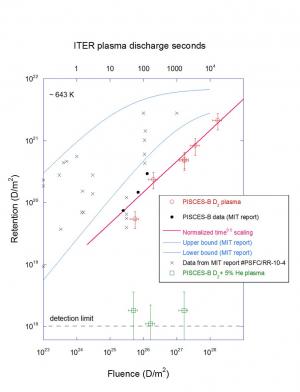Record plasma fluence exposure in UC San Diego test stand
27 Feb 2015
-
R.P. Doerner and the PISCES team, UCSD
The retention measurements are plotted at the right against the database contained in an MIT report (#PSFC/RR-10-4) which addresses this issue. Also evident in the plot is that the high plasma flux achievable in PISCES-B (1.5 × 1023 m-2s-1) results in a lower level of retention, compared to the data contained in the MIT report which were collected under lower flux conditions.
The PISCES-B device, located at the University of California San Diego (US), is a linear plasma test stand whose mission is to examine plasma-materials interactions for ITER and future DEMO devices.
In late 2014, PISCES-B was used for a series of high-fluence plasma exposures to investigate the deuterium fuel retention properties of tungsten when exposed to continuous plasma bombardment. The goal was to determine whether the fuel retention in the tungsten saturates with fluence, or continues to increase as a function of the plasma exposure time.
The deuterium particle fluence was varied by almost three orders of magnitude with the maximum deuterium atom fluence being 2 × 1028 m-2. To achieve the maximum fluence exposure, the PISCES-B device was run continuously for over 30 hours, reaching a fluence equivalent to 50 full-power 400-second ITER deuterium-tritium plasma pulses.
The experiment demonstrates the ability of linear plasma devices to operate in true steady state and to provide a test platform which can replicate plasma-material interaction conditions relevant to future DEMO reactors.
During pure deuterium plasma exposure, retention results indicate that saturation is not reached and that retention scales as the square root of time, indicative of diffusion dominating the fuel uptake of the tungsten.
The retention measurements are plotted in the graph at right against the database contained in an MIT report (#PSFC/RR-10-4) which addresses this issue. Also evident in the plot is that the high plasma flux achievable in PISCES-B (1.5 × 1023 m-2s-1) results in a lower level of retention, compared to the data contained in the MIT report which were collected under lower flux conditions.
However, measurements performed while sculpting the PISCES plasma to replicate a burning plasma, by adding a small amount (5 percent) of helium to the incident deuterium plasma, indicate the deuterium uptake in the target is severely inhibited. The diffusion barrier provided naturally by the helium ash contained in a burning plasma could alleviate many tritium-related concerns in future fusion reactors with tungsten plasma-facing materials.


